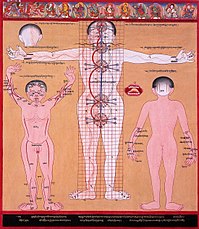begin quote from:
Trul khor
| Trul khor | |||
| Tibetan name | |||
|---|---|---|---|
| Tibetan | རྩ་རླུང་འཁྲུལ་འཁོར་ | ||
| Literal meaning | magical movement instrument, channels and inner breath currents | ||
| |||
Tsa lung trul khor (Sanskrit: vayv-adhisāra "magical movement instrument, channels and inner breath currents"), known in short as trul khor "magical instrument" or "magic circle" (adhisāra[1]) is a Vajrayana discipline which includes pranayama (breath control) and body postures (asanas). From the perspective of the Indo-Tibetan Buddhist traditions of Dzogchen, the mind is merely vāyu (breath) in the body. Thus working with vāyu and the body is paramount, while meditation, on the other hand, is considered contrived and conceptual.
The late Namkhai Norbu Rinpoche (1938-2018), a prominent proponent of trul khor, preferred to use the equivalent Sanskrit term, Yantra Yoga, when writing in English. Trul khor derives from the instructions of the Indian mahasiddhas (great sages) who founded Vajrayana (3rd to 13th centuries CE).
Trul khor traditionally consists of 108 movements, including bodily movements (or dynamic asanas), incantations (or mantras), pranayama and visualizations.[citation needed] The flow or vinyāsa of movements are likened[by whom?] to prayer beads.
The walls of the Dalai Lama's summer temple of Lukhang depict trul khor asanas.
Lung[edit]
Lung (Tibetan:རླུང; Wylie: rlung) is equivalent to the Sanskrit vāyu.
English discourse[edit]
Namkhai Norbu was the first to discuss Trul Khor in English with his book on Yantra Yoga,[2] essentially a commentary on a practical yoga manual by Vairotsana. Namkhai Norbu began dissemination of Yantra Yoga through his practical teaching and esoteric transmission of this discipline within the International Dzogchen Community, which he founded some time after 1975 in Italy, Merigar.
Chaoul (2006) has begun discussion of Bon traditions of Trul Khor in English with his thesis from Rice University.[3] In his work, Chaoul makes reference to a commentary by the famed Bonpo Dzogchen master, Shardza Tashi Gyaltsen.
Tenzin Wangyal Rinpoche's text Awakening the Sacred Body presents some of the basic practices of trul khor according to the Tibetan Bön tradition.[4]
Primary texts[edit]
- Tibetan: འཕྲུལ་འཁོར་ཉི་ཟླ་ཁ་སྦྱོར་གྱི་དགོངས་འགྲེལ་དྲི་མེད་ནོར་བུའི་མེ་ལོང, Wylie: 'phrul 'khor nyi zla kha sbyor gyi dgongs 'grel dri med nor bu'i me long
- Shardza Tashi Gyaltsen: byang zab nam mkha' mdzod chen las snyan rgyud rtsa rlung 'phrul 'khor

No comments:
Post a Comment